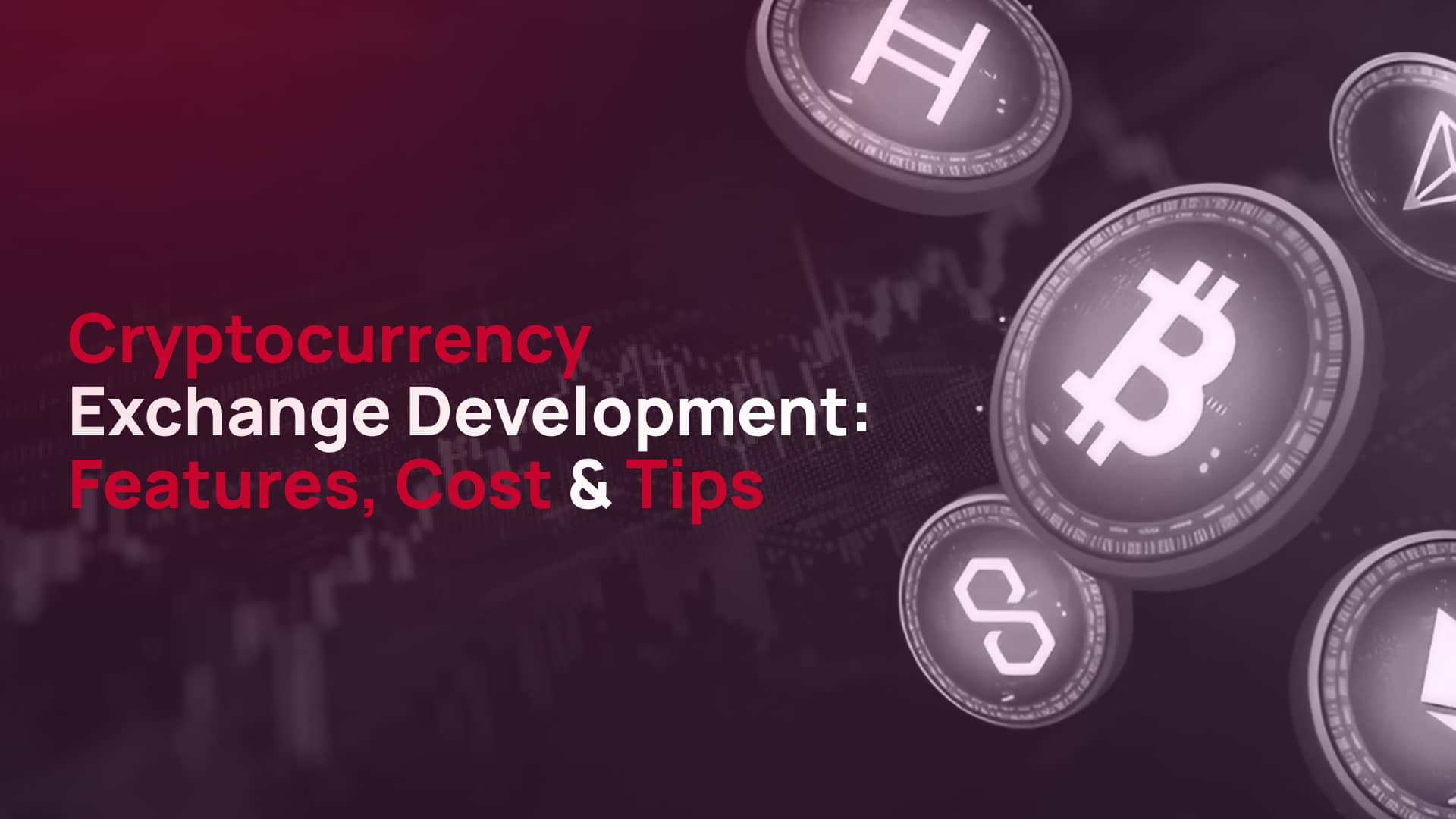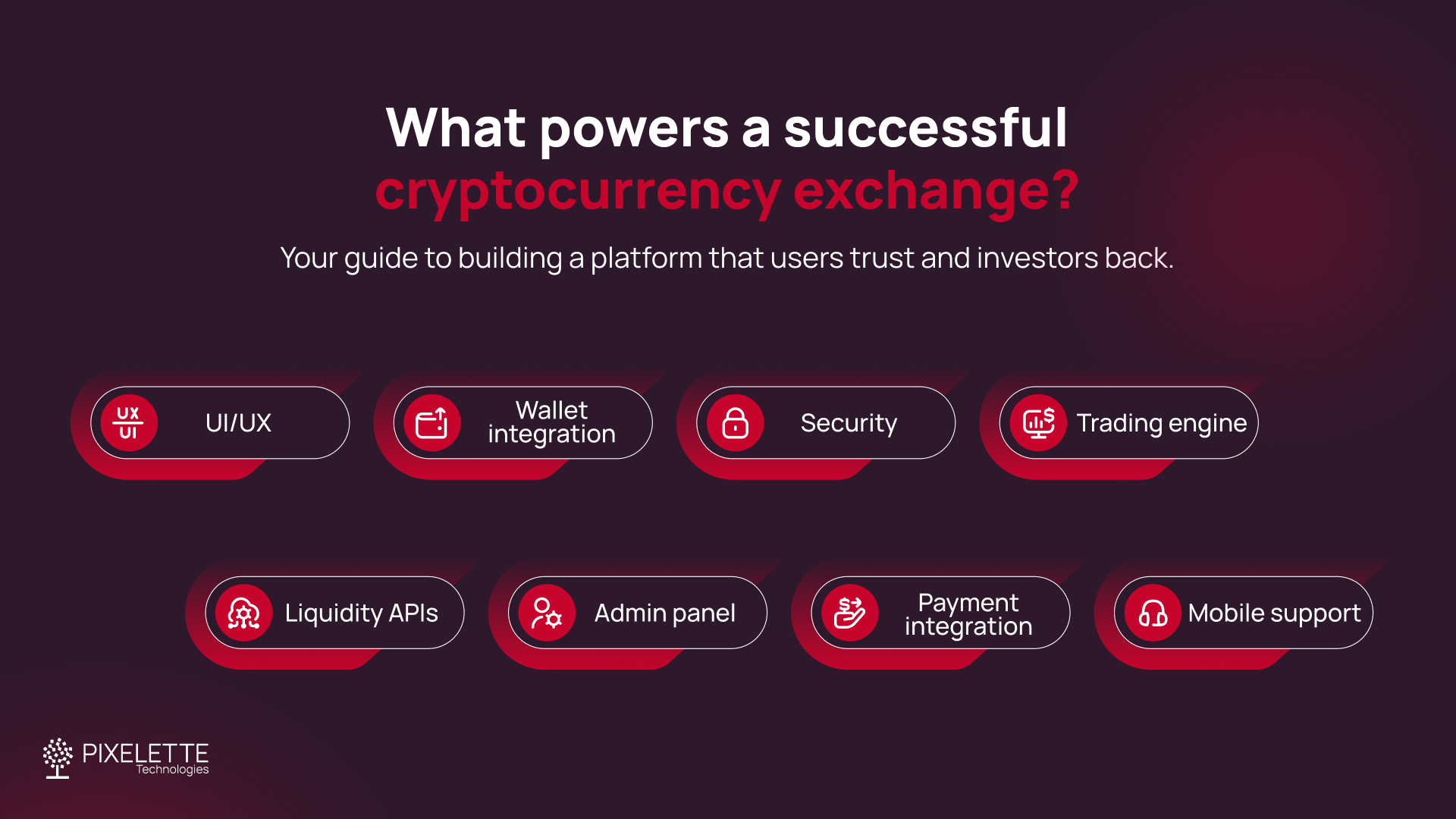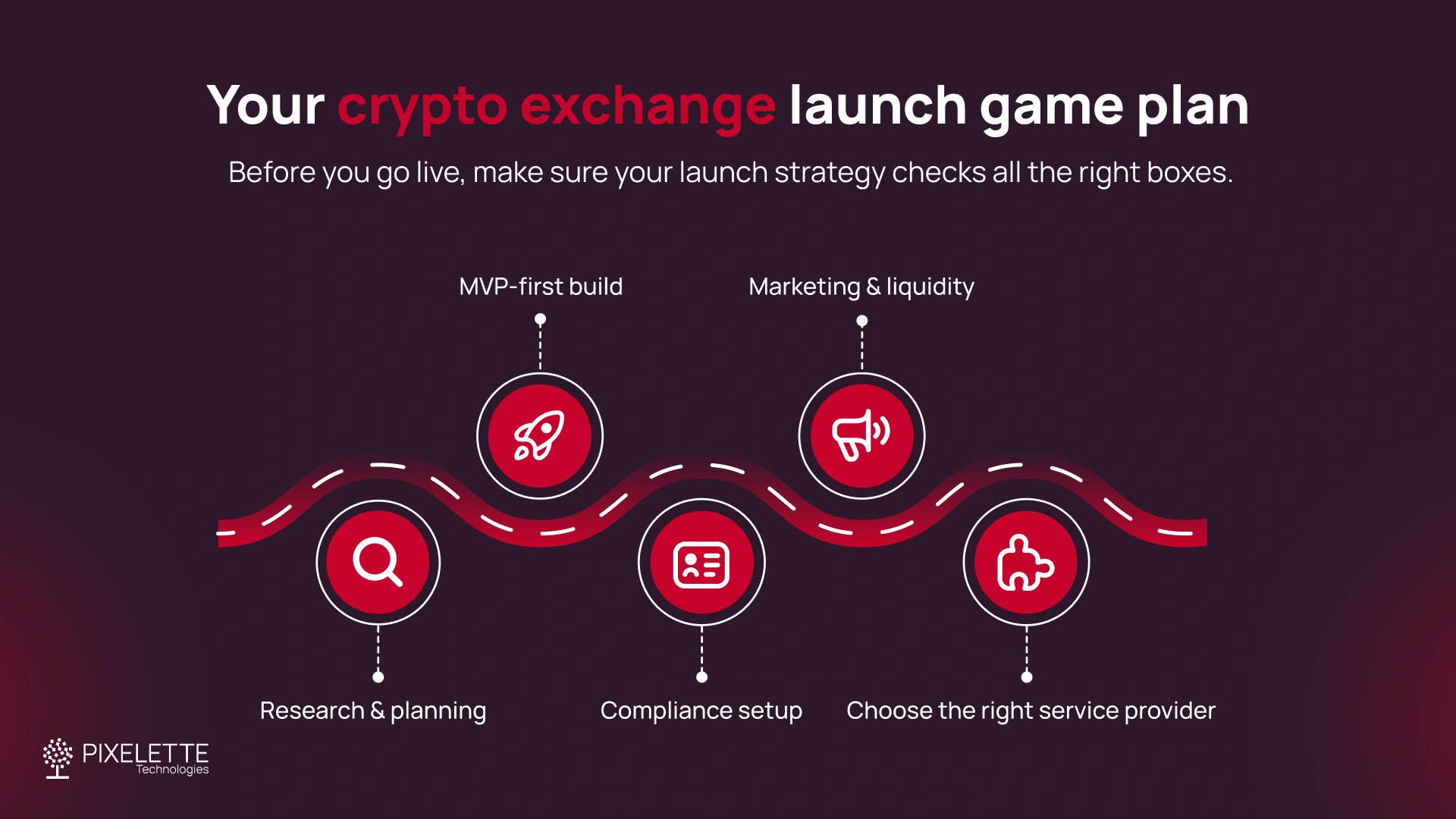Cryptocurrency Exchange Development: Features, Cost & Tips
Written by
Faisal Jaswal
Last Updated: June 26, 2025

In this article
- What is cryptocurrency exchange development?
- Key features to include in a crypto exchange platform
- What's custom cryptocurrency exchange development?
- And what's white label crypto exchange development?
- Factors that influence the cost of developing a cryptocurrency exchange
- Choosing the right cryptocurrency exchange development company
- ⚡️ Bonus: tips for a successful crypto exchange launch
- Conclusion
Your Blockchain Journey Starts Here
Whether you're launching a DeFi platform, NFT marketplace or enterprise blockchain solution, we deliver technology that transforms. Book Your Free Consultation Today.
Cryptocurrency exchange development is no easy task, but it’s not impossible either. It's challenging, especially with platforms like Coinbase and Binance, which handle millions of users and the massive trading volumes that come with them. Not to mention the handling of trades across a growing number of digital assets, with new cryptocurrencies constantly entering the market.
Based on a recent report, the global count of people who became digital currency owners crossed 700 million, reflecting a 163% CAGR (compound annual growth rate) when looked at over the past 5 years. All this points toward a massive global shift in cryptocurrency adoption. So what’s the driving force behind this growth? It’s the fact that there are cryptocurrency platforms that support the digital currency ecosystem.
However, given how fast the market is growing, the demand for user-friendly, yet fast and secure, digital currency trading platforms is still high. And that is why many startups and traditional financial institutions, as well as blockchain ventures, are opting for the development of cryptocurrency exchanges. This article breaks down the process of cryptocurrency exchange development, covering key features, estimated costs, and expert tips for a successful launch.
What is cryptocurrency exchange development?
Before we can begin to look into the tips and tricks and other aspects related to cryptocurrency exchange development, it is best to define what it actually means.
Simply put, it involves building a digital trading platform that supports the buying, selling, and trading of digital currencies by people. These exchanges act as intermediaries that help run the blockchain economy. They provide liquidity and facilitate crypto transfers between users.
There are three major types:
| Type | Pros | Cons |
| CEX (Centralized Exchange) | High speed, easy UI, high liquidity | Custodial, central point of failure |
| DEX (Decentralized Exchange) | Non-custodial, anonymous, permissionless | Slower transactions, lower liquidity |
| Hybrid (Combines CEX UI with DEX architecture) | Balanced control and security | Complex to build and maintain |
We know some of you might be wondering, why not just use existing platforms? The fact is, building a cryptocurrency platform can be highly profitable. The potential to generate revenue through trading fees and premium features is a key motivator for many businesses. That is why many venture capitalists, DeFi projects, and startups find it attractive, especially when looking toward implementing it for niche-based or localized services.
Furthermore, many businesses also see exchanges as a route to brand differentiation, offering local tokens, specialized instruments like derivatives or perpetuals, or compliance-led design (as seen in the UAE or Hong Kong markets).
We’ll go in-depth on this later, but it’s important to note upfront that developing a crypto exchange requires both complex technical planning, such as backend architecture, wallet security, and API integration, and strategic business decisions, including revenue models, regulatory compliance, and liquidity management.
📥 Also read → Best Blockchain Development Trends in 2025
Key features to include in a crypto exchange platform
Certain characteristics are a must-have when it comes to the development of a crypto exchange. The platform should provide a smooth, user-friendly experience, operate without lags or glitches, and include state-of-the-art security protocols.

We have listed and elaborated on them below:
1. User interface (UI) and user experience (UX)
Clean, intuitive dashboards
Responsive design for desktop and mobile
Real-time updates, order tracking, and notification system
2. Multi-currency wallet integration
Usability with most major digital currencies, e.g., BTC, ETH, USD, and others, as well as stablecoins
Cold/hot wallet management
User-controlled deposits and withdrawals
3. Security features
Multi-factor (MFA) or at least two-factor authentication (2FA) and biometric login support
SSL encryption and firewall protection
Cold wallet storage for the majority of assets
DDoS protection and anti-phishing alerts
KYC/AML integration to meet compliance
4. Trading engine
Real-time order matching for high-speed trading
Support for market, limit, and stop orders
Historical trade data and open order tracking
5. Liquidity management
Integration with global liquidity providers
Use of liquidity APIs for dynamic market depth
Market maker bots to ensure active order books
6. Admin panel
Control user accounts, trading pairs, fees, and reports.
Dispute resolution management tools
Analytics dashboards for insights
7. Payment gateway integration
Ensure compatibility with major third-party payment processors.
Allow for the use of cards and bank transfers; accept normal fiat currencies such as USD and others.
Allow crypto deposits and withdrawals.
8. Mobile app support
Mobile-first design is essential.
Cross-platform compatibility for Android and iOS
Push notifications and biometric login for ease
What's custom cryptocurrency exchange development?
When it comes to cryptocurrency exchange development, especially customized ones, it involves creating one from scratch. It will be built around your specific requirements that include aspects such as your target market, features you want to offer, and your brand. This is ideal for:
Startups with unique value propositions
Companies targeting specific regions or trading pairs
Organizations and corporations looking to scale up in the long run
The benefits? Well, besides the lucrative monetization options, they include the control, flexibility and freedom to choose the features you want. At this stage, there are key aspects that are often overlooked such as compliance and technical expertise. One effective way to address these is by partnering with a specialized cryptocurrency exchange development company.
❓Find out → Why Choose a dApp Development Company for Solutions
And what's white label crypto exchange development?
White label crypto exchange development provides you with a turnkey solution: a pre-built exchange software that is customizable. It suits:
Companies seeking quicker time-to-market
Projects that have modest budgets
MVP-phase crypto projects
White-label solutions offer several key advantages. They come with a lower upfront cost, can be deployed quickly, often in just 2 to 4 weeks, and support custom branding along with light feature modifications to fit your business needs.
That said, there are some trade-offs. You'll have limited control over the backend, and the shared architecture may affect how unique your product feels. So, a white-label approach makes sense when speed is critical and your business model doesn’t require deep customization.
Factors that influence the cost of developing a cryptocurrency exchange
Here’s a breakdown of what affect costs for a crypto exchange's development:
Type of exchange i.e. CEX, DEX, or hybrid
Set of features required like advanced trading tools, KYC/AML, wallet integrations
Security layers and testing protocols
Custom vs. white label crypto exchange development
Developer location (US/UK firms charge more than Asia-based teams)
Cost is also affected by deployment choices. For example, if you opt for a cloud-based solution based on AWS or Kubernetes, the initial investment will be greater, but future scaling is much easier. Then there is the chance of regulatory-based charges, such as those for acquiring licenses or any legal fees based on the region you are operating from. For example, $10,000 (in Lithuania or Estonia) to over $100,000 (in Singapore, Dubai, or the US).
Note → Ongoing maintenance and upgrades can cost an additional 15–25% of the initial development cost each year. This includes server monitoring, patch releases, customer support, feature updates and compliance updates. Neglecting this often results in downtime or regulatory penalties.
Choosing the right cryptocurrency exchange development company
If you're unable to do it yourself or hire a team, the next best option is to outsource it to experts. Selecting a capable development company is crucial to success.
What to look for when outsourcing
Proven portfolio or demo products
Focus on security, not just UI/UX
Knowledge of regulatory compliance across jurisdictions
Transparent pricing and agile development cycles
Red flags to look out for in a service provider
No live case studies or references
Generic slide decks instead of product walkthroughs
Unrealistic timelines or budget quotes
Pro tip → Ask for a live testnet demo. It’ll show whether they’re the real deal.
⚡️ Bonus: tips for a successful crypto exchange launch
Everyone has their own ways of going about launching crypto products and platforms, but here are some well-documented (and recommended) steps that can help you create a roadmap for your crypto exchange launch.
1. Research and planning
Do your research, study the market, competitors, and needs. Be aware of the jurisdictions you will be operating in. Countries such as the UAE, UK, and Switzerland are crypto-friendly and require a license. The plan also involves the use of either a mobile-first or desktop-first interface.
2. MVP-first strategy
Start small with a minimum viable product in your exchange with critical features. Iterate based on user feedback. This saves time-to-market and provides time to enhance UI, liquidity options, and/or niche trading pairs after the launch.

3. Legal & regulatory book
Legal and regulatory compliance ensure that your licenses, AML policies, and KYC are in place, depending on the region. You might also need data privacy, audit trails, or tax reporting (such as FATF compliance), depending on the country.
4. Marketing & liquidity generation
Get the community involved early, work with market makers, and conduct PR campaigns. It might be a good idea to be listed on services such as CoinMarketCap or integrated with wallets to increase exposure.
5. Partner with specialists
Work with experienced providers of cryptocurrency exchange development services to avoid costly errors. A vendor should always possess a verifiable security and compliance history. Tools like bug bounty programs or third-party code verification (e.g., CertiK, Hacken) create preliminary trust.
Conclusion
The rise of cryptocurrencies to the mainstream has made the opening of crypto exchanges more accessible than ever before. But success depends on choosing a suitable development model, building essential and unique features that fulfil demand, and partnering with the right cryptocurrency exchange development company.
Whether you're opting for white-label or going for custom crypto exchange development, you should strive to make sure that your platform is secure, compliant, and user-focused. Even newcomers can develop competitive platforms that compete with leading exchanges with the right tools and guidance.
For tailored advice, reach out to firms that offer cryptocurrency exchange development services like Pixelette Technologies and take your blockchain vision from idea to launch. Now the question is, are you ready to begin?




